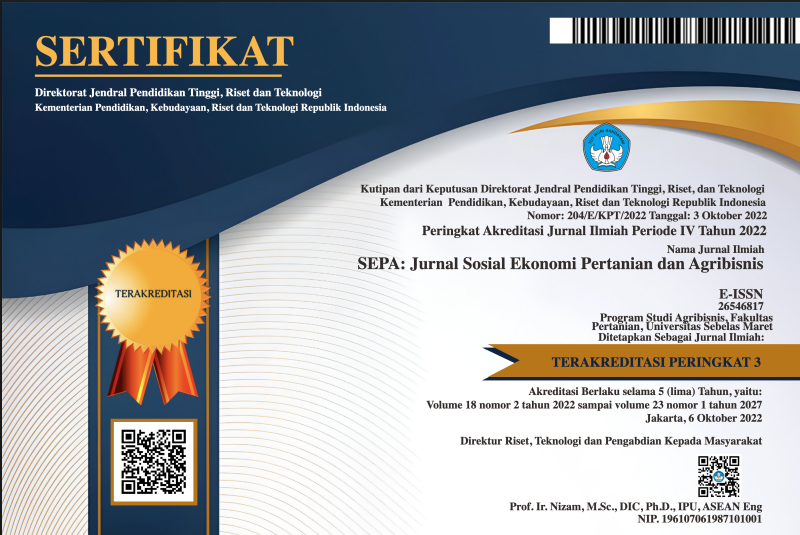KONTRIBUSI PENDAPATAN TENAGA KERJA WANITA PADA USAHA EMPING MELINJO TERHADAP PENDAPATAN KELUARGA DI DESA PLUMBON KECAMATAN LIMPUNG KABUPATEN BATANG
Abstract
The purpose of this research is to find out 1)the reasons why women workers work in melinjo chips, 2)the average allocation of women's work hours in melinjo chips, 3)the contribution of women workers to melinjo chips businesses on family income and, 4)factors that influence women's income contribution to the melinjo chips business. Respondents were taken by purposive sampling with the number of respondents as many as 45 women workers in 3 business ventures in Plumbon Village, Limpung District, Batang Regency. The results showed that the reason of women work in the business seen from dominant economic factors to help husbands find additional household income. While social factors, namely to fill spare time. The average working hours of women workers in melinjo business is 8 hours/day. The contribution of women workers in the emping melinjo business to family income was 33,68 percent. R2 value obtained using multiple linear regression models of 0.686 shows that the proportion of the influence of independent variables (women's income, husband's income and the number of family dependents) on the dependent variable in the form of women's income contribution to the melinjo chips business was 68.6% while the remaining 31.4% is influenced by other variables not found in the linear regression model in this study. The results of the F-test and t-test showed that the variance in women's income, husband's income and the number of family dependents had a significant effect on women's income contribution.
Keywords
Full Text:
PDFReferences
Amin, M. N. (2016). Kontribusi tenaga kerja wanita pada usaha emping melinjo terhadap pendapatan keluarga. Jurnal Mediagro, 12(2), 26–38.
Badan Pusat Statistik. (2018). Badan Pusat Statistik. Kabupaten Batang Dalam Angka. Batang: BPS Kab. Batang.
Christoper, R., Chodijah, R. & Yunisvita (2017). Faktor-faktor yang mempengaruhi pendapatan pekerja wanita sebagai ibu rumah tangga. Jurnal Ekonomi Pembangunan, 15(1), 35–52.
Fauziah, F. R., & Soejono, D. (2019). Analisis pendapatan usahatani jamur merang dan kontribusinya terhadap pendapatan
rumah tangga petani di Kelurahan Sempursari Kecamatan Kaliwates Kabupaten Jember. SEPA, 15(2), 172–
Kesselman, A. (1999). Women Imagesand Realities; A Multicultural Anthology. (Second Edition). Mayfiels Publising
Company.
Nurung, M., Priyono, B. S., & Yuniarti, F. (2005). Analisis curahan waktu kerja dan hubungannya dengan pendapatan wanita pedagang pengecer sayuran. Jurnal Agrisep, 14, 1.
Rahaju, M. E. E., Mulyati, T., & Sumarlan. (2012). Motivasi wanita bekerja dan pengaruhnya terhadap kontribusi pendapatan keluarga (Studi kasus di Kecamatan Taman Kota Madya
Madiun). Jurnal Penelitian Ekomaks Fakultas Ekonomi Universitas Merdeka. Madiun, 1(2), 80–94.
Ramadhan. (2004). Kontribusi pendapatan perempuan tani pada usahatani padi sawah terhadap pendapatan keluarga di Desa Lhok Keutapang Kecamatan Tangse Kabupaten Pidie [Electronic
Thesis and Dissertation Universitas Syiah Kuala Darussalam]. Banda Aceh.
Sinadia, J. B. C., M.Wangke, W., & M.Benu, N. (2017). Kontribusi buruh perempuan terhadap pendapatan keluarga (Studi kasus tempat pelelangan ikan di Tumumpa Kota Manado). Jurnal
Penelitian Agri-Sosio Ekonomi Unsrat. Manado, 13, 253–260.
Skirbekk, V. (2004). Age and individual productivity : A literature survey, Vienna Yearbook of Population Research, 2(1),
–154.
Soebyakto, B. B. (2016). Migrant women working at informal sectors : Empirical study in Kuto Batu Village, Ilir Timur Ii
Palembang City. International Journal of Humanities and Social Science, 6(4), 125–137.
DOI: https://doi.org/10.20961/sepa.v17i2.44609
Refbacks
- There are currently no refbacks.



.png)







.png)
3.png)





